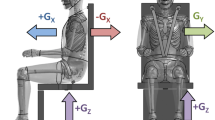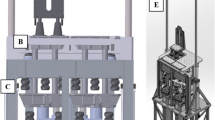Abstract
Previous studies involving whole-body post-mortem human surrogates (PHMS) have generated biomechanical response specifications for physically simulated accelerative loading intended to reproduce seat and floor velocity histories occurring in under-body blast (UBB) events (e.g.,. References 10, 11, 21 These previous studies employed loading conditions that only rarely produced injuries to the foot/ankle and pelvis, which are body regions of interest for injury assessment in staged UBB testing using anthropomorphic test devices. To investigate more injurious whole-body conditions, three series of tests were conducted with PMHS that were equipped with military personal protective equipment and seated in an upright posture. These tests used higher velocity and shorter duration floor and seat inputs than were previously used with the goal of producing pelvis and foot/ankle fractures. A total of nine PMHS that were approximately midsize in stature and mass were equally allocated across three loading conditions, including a 15.5 m/s, 2.5 ms time-to-peak (TTP) floor velocity pulse with a 10 m/s, 7.5 ms TTP seat pulse; a 13 m/s, 2.5 ms TTP floor pulse with a 9.0 m/s, 5 ms TTP seat pulse; and a 10 m/s, 2.5 ms TTP floor pulse with a 6.5 m/s, 7.5 ms TTP seat pulse. In the first two conditions, the seat was padded with a ~ 120-mm-thick foam cushion to elongate the pulse experienced by the PMHS. Of the nine PMHS tests, five resulted in pelvic ring fractures, five resulted in a total of eight foot/ankle fractures (i.e., two unilateral and three bilateral fractures), and one produced a femur fracture. Test results were used to develop corridors describing the variability in kinematics and in forces applied to the feet, forces applied to the pelvis and buttocks in rigid seat tests, and in forces applied to the seat foam in padded seat tests. These corridors and the body-region specific injury/no-injury response data can be used to assess the performance and predictive capability of anthropomorphic test devices and computational models used as human surrogates in simulated UBB testing.







Similar content being viewed by others
Change history
19 November 2021
A Correction to this paper has been published: https://doi.org/10.1007/s10439-021-02886-w
References
AAAM. The Abbreviated Injury Scale. Chicago: Association for the Advancement of Automotive Medicine, 2016.
Agnew, A. M., M. M. Murach, V. M. Dominguez, et al. Sources of variability in structural bending response of pediatric and adult human ribs in dynamic frontal impacts. Stapp Car Crash J. 62:119–192, 2018.
Bass, D., J. Rupp, L. Voo, A. Weaver, N. Yogananadan, K. Loftis, and D.R. Barnes. Normalization and scaling for the development of human injury probability curves: General approach and current recommendation. Report CCDC DAC-TR-2020-042, 2020. Available from: https://apps.dtic.mil/sti/pdfs/AD1103433.pdf.
Chirvi, S., F. Pintar, N. Yoganandan, et al. Human foot-ankle injuries and associated risk curves from under body blast loading conditions. Stapp Car Crash J. 61:157–173, 2017.
Danelson, K. A., A. R. Kemper, M. J. Mason, M. Tegtmeyer, J. H. Bolte, IV, and W. N. Hardy. Comparison of ATD to PMHS response in the under-body blast environment. Stapp Car Crash J. 59:445–520, 2015.
Danelson, K., L. Watkins, J. Hendricks, Pizzolato-Heine K. Frounfelker, R. Valentine, and K. Loftis. Analysis of the frequency and mechanism of injury to warfighters in the under-body blast environment. Stapp Car Crash J. 62:4889, 2018.
Gayzik, F. S., I. P. Marcus, K. A. Danelson, J. D. Rupp, C. R. Bass, N. Yoganandan, and J. Zhang. A point-wise normalization method for development of biofidelity response corridors. J. Biomech. 48(15):4173–4177, 2015.
Gordon, C. C., C. L. Blackwell, B. Bradtmiller, J. L. Parham, P. Barrientos, S. P. Paquette, et al. Anthropometric survey of US Army personnel: Methods and summary statistics (No. NATICK/TR-15/007). Army Natick Soldier Research Development and Engineering Center MA 2012.
Loftis, K. L., E. L. Mazuchowski, M. C. Clouser, and P. J. Gillich. Prominent injury types in vehicle underbody blast. Mil Med. 184(Suppl 1):261–264, 2019. https://doi.org/10.1093/milmed/usy322.
Ott, K. A., C. K. Demetropoulos, M. E. Luongo, J. M. Titus, A. C. Merkle, and D. G. Drewry. Evaluation of the whole body spine response to sub-injurious vertical loading. Ann. Biomed. Eng. 2020. https://doi.org/10.1007/s10439-020-02656-0.
Pietsch, H. A., K. E. Bosch, D. R. Weyland, et al. Evaluation of WIAMan technology demonstrator biofidelity relative to sub-injurious PMHS response in simulated under-body blast events. Stapp Car Crash J. 60:199–246, 2016.
Reed, M. P., and S. M. Ebert. The Seated Soldier Study: Posture and Body Shape in Vehicle Seats. Final Report (UMTRI-2013-13). Biosciences Group, University of Michigan Transportation Research Institute 2013.
Rupp, J. D., C. S. Miller, L. W. Zaseck, N. Orton, A. Bonifas, L. Slykhouse, and M. P. Reed. Forces Applied to the Foot and Pelvis in High Rate Vertical Accelerative Loading. Summer Biomechanics, Bioengineering and Biotransport Conference. National Harbor, Maryland June 30–July 2, 2016.
Salzar, R. S., E. M. Spratley, K. A. Henderson, P. C. Greenhalgh, J. Z. Zhang, B. J. Perry, and J. A. McMahon. The mechanical response and tolerance of the anteriorly-tilted human pelvis under vertical loading. Ann. Biomed. Eng. 2020. https://doi.org/10.1007/s10439-020-02634-6.
Slykhouse, L. R., L. W. Zaseck, C. S. Miller, J. R. Humm, A. Alai, Y. S. Kang, C. Dooley, D. S. Sherman, B. Bigler, C. K. Demetropolous, M. P. Reed, and J. D. Rupp. Anatomically-based skeletal coordinate systems for use with impact biomechanics data intended for anthropomorphic test device development. J. Biomech. 92(162–168):2019, 2019.
Somasundaram, K., L. Zhang, D. Sherman, P. Begeman, D. Lyu, and J. M. Cavanaugh. Evaluating thoracolumbar spine response during simulated underbody blast impact using a total human body finite element model. J. Mech. Behav. Biomed. Mater. 100:2019.
Spink, R. A Simple Method for Processing Measurements of Vehicle Response to Underbody Blast during Live Fire Test and Evaluation. ARL-TR-7030. Army Research Lab, Aberdeen VA 10:10, 2014.
Yoganandan, N., M. W. J. Arun, and F. A. Pintar. Normalizing and scaling of data to derive human response corridors from impact tests. J. Biomech. 47(8):1749–1756, 2014. https://doi.org/10.1016/j.jbiomech.2014.03.010.
Yoganandan, N., N. DeVogle, F. Pintar, and A. Baneerjee. Human pelvis bayesian injury probability curves from whole body lateral impact experiments. J Eng Sci Med Diagn Therapy 3:10, 2020. https://doi.org/10.1115/1.4046672.
Yoganandan, N., S. Chirvi, F. A. Pintar, H. Uppal, M. Schlick, A. Banerjee, L. Voo, A. Merkle, and M. Kleinberger. Foot-ankle fractures and injury probability curves from post-mortem human surrogate tests. Ann. Biomed. Eng. 44(10):2937, 2016.
Zaseck, L. W., A. C. Bonifas, C. S. Miller, N. R. Orton, M. P. Reed, C. K. Demetropoulos, K. A. Ott, C. J. Dooley, N. P. Kuo, and L. M. Strohsnitter. Kinematic and biomechanical response of post-mortem human subjects under various pre-impact postures to high-rate vertical loading conditions. Stapp Car Crash J. 63:235–266, 2019.
Acknowledgments
This work was conducted as part of the Biomechanics Product Team lead by the Johns Hopkins Applied Physics Laboratory for the WIAMan project and funded by the US Army DEVCOM Data and Analysis Center. The authors also offer solemn thanks and gratitude to the subjects, without whom this work could not have been possible, and whose contribution to the betterment of society will live on long after their death.
Author information
Authors and Affiliations
Corresponding author
Additional information
Associate Editor Dan Elson oversaw the review of this article.
Publisher's Note
Springer Nature remains neutral with regard to jurisdictional claims in published maps and institutional affiliations.
In this article the author’s name was incorrectly written as Constantine K. Demetropolous and has been corrected and will appear as Constantine K. Demetropoulos. The original article has also been updated to show the line indicating the timing of the L5 fracture in test WS11-03 has been shifted to the right by ~ 5 ms. Figures 3, 4, 5, and 7 in the original article have been updated to show shaded corridors that were absent in the original version.
Supplementary Information
Below is the link to the electronic supplementary material.
Rights and permissions
About this article
Cite this article
Rupp, J.D., Zaseck, L., Miller, C.S. et al. Whole Body PMHS Response in Injurious Experimental Accelerative Loading Events. Ann Biomed Eng 49, 3031–3045 (2021). https://doi.org/10.1007/s10439-021-02803-1
Received:
Accepted:
Published:
Issue Date:
DOI: https://doi.org/10.1007/s10439-021-02803-1




